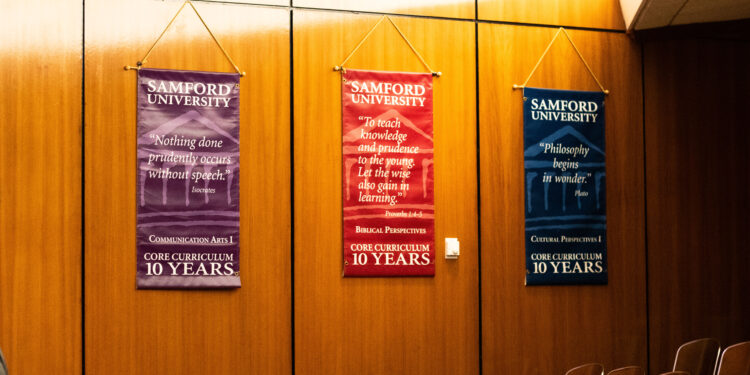In the fall of 2026, the university will be changing their structure of class credit hours from four to three hours. Beginning in the spring of 2026, as students begin to build their schedules and register for classes for the next semester, they will do so according to the new structure.
“This change in credit hour model aligns our academic structure with national standards and facilitates course transferability, scheduling flexibility, and curriculum innovation,” said David Cimbora, Samford’s Provost and Vice President.
Many universities function on a three-credit hour model and aligning the university to the uniform three-credit hour classes across the university helps students to transfer into the university and across majors.
“Changes to the general education curriculum represent a modernization of this set of courses and is the first comprehensive review and update of the general education curriculum in several decades,” Cimbora said. “We want to ensure our students are receiving the most comprehensive and up-to-date course offerings that also align with and emphasize our unique institutional mission.”
This change will affect Howard College of Arts and Sciences specifically, since it is currently entirely on the four-credit hour structure.
Dawn McCormack, the dean of the Howard College, said that the change has allowed the college to reevaluate and update all of the courses.
“I think when we get to the three-hour courses, we’re actually going to have curriculum programs that are the very best that they can be, giving students the very best opportunities we can possibly give them,” she said.
Dana Basinger, Assistant Dean of Howard College, has seen the change in credit hours positively affect students’ ability to add to their course-load.
“This is working really beautifully for students because everybody who’s a sophomore, junior, or senior upcoming, they’re going to have room to fit more in if they want to,” she said.
In 1997, the university first switched to the four-credit hour structure.
Fred Shepherd, professor of political science, began at Samford in 1993. He explained the reasoning behind the switch in the 90’s.
“There was extensive consultation with the faculty about it, and the faculty felt strongly that switching from three to four-credit courses would allow us to focus better on the courses we taught,” he said. “We also thought that it would be beneficial to the students because they could take fewer courses with larger credit amount for each course and also focus more effectively on their fewer number of courses.”
Shepherd said that the faculty were overwhelmingly positive toward the change in the 90’s and it was a very faculty-driven process.
B. Keith Putt, professor of classics and philosophy, has concerns about the change.
“There are a number of reasons that I’m not really happy about the change, but the chief one is, I have yet to have anybody give me a compelling academic reason for doing it,” he said.
Faculty are concerned about the added workload for both students and faculty, as well as the decreased instruction time students will have in the classroom.
In order to continue their expected 12-hour teaching load, professors will need to teach an added course, increasing their preparation time from three to four classes. Although teaching the same number of hours, professors will have to prepare for another class and grade work from more students.
Additionally, Putt is concerned about the decreased time students will spend in the classroom on a specific class.
“On Monday, Wednesday, Friday, you’re taking 10 minutes off each class session,” he said. “You’re going from 65 minutes to 55 minutes. That means over a week, you’re reducing instruction time by 30 minutes, which means over two weeks, that’s a day… Functionally, every two weeks, you’re basically removing a day of instruction.”
Putt maintains his concerns that the credit hour change will negatively impact academics.
“At no point along the way have I heard, … a compelling academic reason,” he said. “It’s almost as if it’s been a decision in search of a rationalization.”
Although faculty have mixed concerns about the credit hour change, McCormack sees the change as positive.
“Having come from an institution that had a three-hour grid, I taught my students in that grid, and I’ve taught four-hour classes here. And we can have students have great success in both systems,” she said. “Change is hard for everybody, but I think that we’ve done everything we can to make this as positive as possible for everyone involved.”

News Editor




